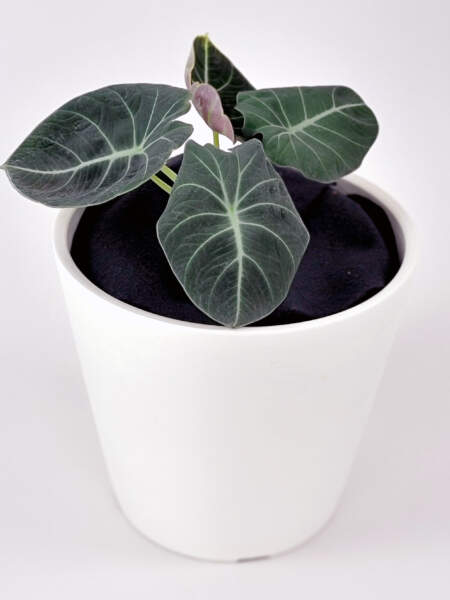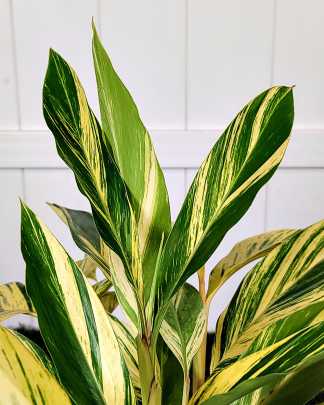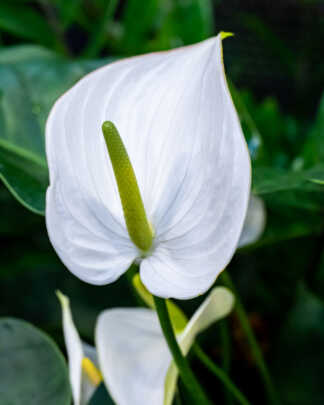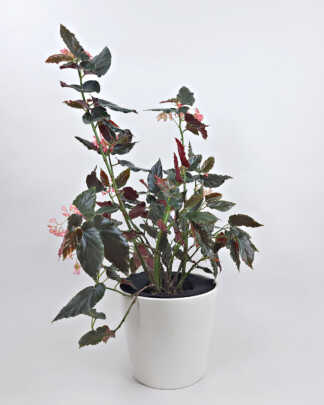Description
This Elephant Ear Epitomizes a Smooth Mystique
The Alocasia reginula ‘Black Velvet’ is a captivating and rare houseplant, renowned for its velvety, dark leaves that create a striking contrast in any indoor plant collection. Originating from Southeast Asia, this exotic plant features large, heart-shaped leaves that are a rich, deep green, almost black in color, with prominent, contrasting white veins. Typically growing up to 12-18 inches tall, it’s perfect for small spaces and tabletops.
Caring for your Alocasia
This Alocasia thrives in a well-draining potting mix and prefers bright, indirect sunlight. It’s essential to maintain consistent moisture without waterlogging the soil, as it’s sensitive to both over and under-watering. Humidity is a key factor for its growth, making it ideal for a bathroom or kitchen setting. It’s a relatively fast grower and can add a dramatic flair to your space.
Caring for Alocasia plants can be a rewarding experience. These plants require attention to detail regarding their environmental needs, but with the right care, they can be a stunning addition to your indoor garden. Remember that each Alocasia variety may have slightly different needs, so it’s always good to research the specific needs of your variety.
Light
Alocasias prefer bright, indirect light. Direct sunlight can scorch their leaves, while too little light can stunt their growth. A north or east-facing window is ideal.
Temperature
These plants thrive in warm environments. Aim to keep the temperature between 65°F and 80°F (18°C to 27°C). Avoid placing your Alocasia in drafty areas or near air conditioning vents.
Soil
A well-draining potting mix is crucial. A mix of regular potting soil, peat, and perlite works well. Ensure the pot has drainage holes to prevent waterlogging.
Water
Water your Alocasia when the top 2-3 inches of soil feel dry. Reduce watering in the winter when the plant’s growth slows down. Overwatering can lead to root rot, a common issue with Alocasia. Alocasias love high humidity. Aim for 60-80% humidity. Use a humidifier, or place the plant on a water-filled pebble tray to increase humidity.
Fertilization
Fertilize your Alocasia every 2-4 weeks during the growing season (spring and summer) with a balanced, water-soluble fertilizer. Reduce feeding in the fall and stop in the winter. Over-fertilization can lead to leaf burn, so it’s important to follow the recommended dosage.
Pruning and Maintenance
Prune any yellowing or dead leaves to encourage new growth. This can be done year-round. Cleaning the leaves with a damp cloth not only keeps the plant looking its best but also allows for efficient photosynthesis.
Pest and Disease Management
Alocasias are susceptible to pests like spider mites, aphids, and mealybugs. Regularly inspect your plant and treat any infestations promptly with insecticidal soap or neem oil. Avoid overwatering and ensure good air circulation to prevent fungal diseases.
Propagation
Propagate Alocasia through division during repotting. Gently separate offsets from the mother plant and pot them in a similar soil mix. This is best done in the spring or early summer.
Potting and Repotting
Repot your Alocasia every 1-2 years or when it becomes root-bound. Choose a pot that’s slightly larger than the current one. Repotting provides the plant with fresh soil and more room to grow.



















Mark Alonzo (verified owner) –
Came well packaged and in amazing condition.
Anonymous (verified owner) –
Anonymous (verified owner) –
Anonymous (verified owner) –
Carson S. (verified owner) –
Perfect
Anonymous (verified owner) –
Healthy & thriving.
Cathy Lance (verified owner) –
Beautiful healthy plant – arrived perfect.
Nicole C. (verified owner) –
Craig O. (verified owner) –
Looks like picture. Would recommend.